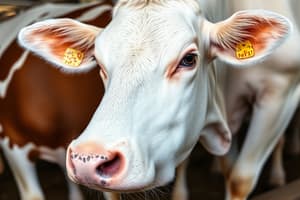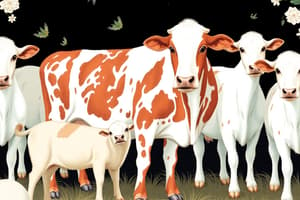Podcast
Questions and Answers
What is the average amount of milk consumed by each American?
What is the average amount of milk consumed by each American?
- 100 gallons
- 10 gallons
- 23 gallons (correct)
- 50 gallons
What percentage of milk fat is found in the milk produced by a humpback whale?
What percentage of milk fat is found in the milk produced by a humpback whale?
- 3% to 5%
- 87%
- 42% (correct)
- 20%
How many cows can be milked at the same time with the help of a milking machine?
How many cows can be milked at the same time with the help of a milking machine?
- 500 cows
- 50 cows
- 100 cows (correct)
- 200 cows
What is the primary purpose of separating the calf from its mother within one hour of birth?
What is the primary purpose of separating the calf from its mother within one hour of birth?
What is the name of the farm near Fresno, California, that is taking milking to a new level?
What is the name of the farm near Fresno, California, that is taking milking to a new level?
How often is the milk picked up from the dairy farm to be sent to a processing center?
How often is the milk picked up from the dairy farm to be sent to a processing center?
What percentage of dairy cows are of the Holstein breed?
What percentage of dairy cows are of the Holstein breed?
How does the DeLaval Rototech Parlor sanitize the cow's teats?
How does the DeLaval Rototech Parlor sanitize the cow's teats?
What is the purpose of the flow sensor in the milking process?
What is the purpose of the flow sensor in the milking process?
What is the main component of milk, by percentage?
What is the main component of milk, by percentage?
Flashcards
Milking Machine
Milking Machine
A mechanized system used in dairy farms, where a single farmer can milk over 100 cows simultaneously, greatly increasing efficiency. It has been used for over a century.
DeLaval Rototech Parlors
DeLaval Rototech Parlors
Bovine carousels used on large dairy farms to milk up to 80 cows at once, improving efficiency by up to 30%. Cows are sanitized, stimulated, and milked.
Voluntary Milking System (VMS)
Voluntary Milking System (VMS)
An automatic system that scans cows, automating the milking process. This system allows cows to be milked whenever they want, reducing the need for farmhands.
Pasteurization
Pasteurization
Signup and view all the flashcards
Homogenization
Homogenization
Signup and view all the flashcards
Butter
Butter
Signup and view all the flashcards
Yogurt
Yogurt
Signup and view all the flashcards
Sweetened Condensed Milk
Sweetened Condensed Milk
Signup and view all the flashcards
Nonfat Dry Milk
Nonfat Dry Milk
Signup and view all the flashcards
Plant-Based Milk
Plant-Based Milk
Signup and view all the flashcards
Study Notes
• The United States produces over 21 billion gallons of milk every year, which is an average of 23 gallons for each American.
• Virtually all of the milk comes from 60,000 dairy farms in the United States, courtesy of more than 9 million cows bred specifically for the purpose.
• The milking machine has been used for over a century, and it lends a helping, mechanized hand to farmers, allowing one farmer to milk more than 100 cows at the same time.
• The way a farmer treats the cow can affect the milk she gives, and the better the farmer treats the animal, the longer it will last and the more milk it will produce.
• The Larry Shehadey Dairy Farm near Fresno, California, is one of many farms taking milking to a new level that improves cow comfort and increases production.
• The farm uses DeLaval Rototech Parlors, which are bovine carousels that allow as many as 80 cows to be milked at a time, improving efficiency by up to 30%.
• The parlor works by sanitizing each cow's teats with an iodine solution, then attaching cups that stimulate the cow with pulsation to extract the milk.
• The milking process takes about seven minutes, and a flow sensor detects when the cow is running on empty, automatically removing the units.
• For smaller farms, the robotic Voluntary Milking System (VMS) is an option, which eliminates the need for farmhands to assist the cows and allows the cows to be milked when they want to.
• The VMS scans the cow for height and weight, and then a robotic arm images and processes the individual cow, automating the entire process.
• A dairy cow spends up to eight hours a day eating nearly 100 pounds of feed and drinking 80 gallons of water to produce up to 10 gallons of milk seven days a week.
• Modern breeding and a more nutritious diet have contributed to a quantum leap in productivity, with dairy cows producing three times more milk than they did 50 years ago.
• A dairy cow starts producing milk at age two, after delivering her first calf, and farmhands separate the mother and calf permanently within one hour of birth to prevent the calf from introducing harmful bacteria to its mother's udder.
• The milk produced by dairy cows is a nutrient-rich liquid that is 87% water, and the process begins when four chambers in the cow's stomach digest food and break down its nutrients.
• The nutrients then enter the cow's bloodstream, and within one hour, more than 400 gallons of blood have passed through the circulatory system and transported nutrients to help produce one gallon of milk in the cow's mammary glands.
• Dairy farmers pump the milk to refrigerated storage tanks to cool it down to about 37 or 38 degrees Fahrenheit, and it is picked up every 48 hours and sent off to a processing center to be made into dairy products.
• Although cows are the most abundant source of milk, producing an average of 80 pounds per day with about 3% to 5% milk fat, milk flows from all of nature's mammals, including humans, mice, pigs, and horses.
• No mammal can come close to the output of the humpback whale, which produces a whopping 1,000 pounds of milk to its calf every day with 42% milk fat.
• The Holstein breed dominates the dairy industry, with 91% of all dairy cows being Holsteins, which produce the highest amount of milk and have the closest nutrient composition to fluid milk consumed in a bottle from a store.
• The Holstein may be the queen of today's barnyard, but 4,000 years ago, other breeds ruled, including the predecessor to the Holstein, the Ankole-Watusi, which continues to supply milk in Africa today.• 150,000 gallons of raw milk are delivered daily from nearby farms to Driftwood dairy, where it's tested for fat and salt content, and antibiotics before being accepted. • Driftwood dairy uses a centrifugal separator to separate the raw milk into cream and skim milk, with the cream containing around 20% butter fat and the skim milk containing less than 0.1% butter fat. • The skim milk is used as the basis for fluid milk, while the cream is blended with other ingredients to achieve the desired taste and fat content in various products, such as flavored milks. • The milk is pasteurized by heating it to 162 degrees Fahrenheit for 15.5 seconds to kill virtually all bacteria, and then cooled back to 38 degrees Fahrenheit. • The pasteurization process takes less than 40 seconds and kills 99% of the milk's bacteria. • Before the advent of pasteurization, most milk consumed was raw, and bacteria in the milk multiplied, causing spoilage and exposing millions to potentially deadly microorganisms. • Louis Pasteur pioneered the solution to this problem in 1862, and by the 1930s and 1940s, pasteurization was widely recognized as reducing the incidence of foodborne outbreaks associated with milk consumption. • Today, over 95% of the milk we buy in stores is pasteurized. • After pasteurization, milk undergoes homogenization, where milk fat is broken down into small, uniform particles throughout the milk. • The milk is then packaged and stored in a refrigeration area at 32 degrees Fahrenheit before being shipped to schools, restaurants, and other businesses. • Samples of milk are taste-tested by industry experts to ensure a safe and consistent product. • Milk is a good source of vitamins, minerals, and protein, and is essential for building strong bones, making it a vital part of a healthy diet. • Lactose-free milk is available for those who are lactose intolerant, which affects over 30 million Americans and over 70% of the world's population. • Chocolate milk is a healthy energy drink that provides good nutrients without added calories, fat, or pounds. • Butter is made from cream that has been pasteurized, cooled, and then churned to separate the fat globules and form butter. • The churning process breaks the slippery outer shells of the cream's fat globules, exposing the sticky portion inside, which causes the fat particles to stick together. • Yogurt is made by adding healthy bacteria to pasteurized skim milk, which ferments and coagulates, producing lactic acid and a tangy flavor. • The bacteria in yogurt help with digestion, regularity, and other bodily functions, making it a healthy food choice. • Sweetened condensed milk is made by evaporating 70% of the skim milk's water and then mixing it with cream and sugar. • The condensed milk is then pasteurized, and additional water is removed in a giant evaporator to produce a sweet, creamy product. • Evaporated milk can be stored for over a year without refrigeration, making it a convenient option for cooking and baking. • Nonfat dry milk is made by evaporating milk and then spray-drying it into a powder that can be stored for up to a year. • Milk components, such as lactose, milk fat, protein, and minerals, are used in a variety of products, including cereal, orange juice, and pharmaceuticals. • Casein, a type of protein, is used in cheese production, sausage, salad dressings, paint, glue, and cosmetics due to its adhesive properties. • Milk can be obtained from sources other than cows, such as goats, water buffalo, and yaks, which require specialized equipment and milking techniques.- Queenie, the water buffalo, is a key milk producer at River Valley Ranch, and her milk is used to make mozzarella cheese with a distinct flavor.
- The ranch's animals, including water buffalo and goats, graze on blackberry thickets to produce cheese with a fruity flavor.
- Goat milk cheese is a growing specialty, with nearly 50% of the US market being imported from other countries, providing a lucrative opportunity for small farmers.
- Dairy goat farming is more economical than traditional farming, as goats eat less, require less land, and produce multiple offspring.
- Each goat produces up to a gallon of milk per day, which must be cooled to under 40 degrees within two hours or used in a cheese vat.
- Goat milk, buffalo milk, and yak milk are whiter than cow milk due to the animals' ability to convert beta carotene into vitamin A before milking.
- Goat milk has a milder reaction in consumers with milk allergies due to its protein formation.
- Plants, including rice, oats, and nuts, are used to create a milky-looking beverage as a milk substitute, offering similar nutritional benefits.
- Soy milk is the most popular plant-based milk, high in protein and easily processed, making it a popular choice for vegans and those with milk allergies.
- Soy milk must be fortified with calcium and vitamins, such as B-12, but is cholesterol-free and offers a popular alternative to traditional milk.
Studying That Suits You
Use AI to generate personalized quizzes and flashcards to suit your learning preferences.



